Lepidoteuthidae
Lepidoteuthis grimaldii
The scaled squid
Richard E. Young and Michael VecchioneIntroduction

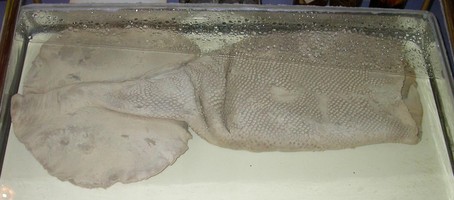
Figure. Ventral view of fins and mantle of syntype of L. grimaldii. Photograph by M. Vecchione.
L. grimaldii is a large squid (100 cm ML) whose tentacles fail to grow much beyond the paralarval stage and are lost in subadults. It has a mantle mostly covered with overlapping dermal cushions (= "scales"). This squid is rarely captured and little is known of its biology.
Brief diagnosis:
A member of the lepidoteuthid families ...
- without tentacles.
- with biserial suckers on arms.
- with dermal cushions (scales) on mantle.
Characteristics
- Arms
- Arms with biserial suckers; single hook present near base of each arm II in males only (Jackson and O'Shea, 2003).
 Click on an image to view larger version & data in a new window
Click on an image to view larger version & data in a new window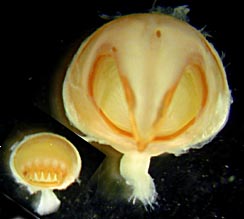
Figure. Oral views of a hook from arm II and adjacent sucker of L. grimaldii showing size comparison, 220 mm ML, immature male, Hawaiian waters. Outer horny ring and associated tissue removed. Photograph by R. Young.

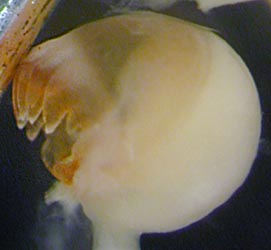
Figure. Side views of the same hook and sucker from L. grimaldii. Photographs by R. Young.
- Arms with biserial suckers; single hook present near base of each arm II in males only (Jackson and O'Shea, 2003).
- Tentacles
- Tentacles absent in subadults and adults; greatly reduced in juveniles.
- Tentacles absent in subadults and adults; greatly reduced in juveniles.
- Head
- Beaks: Descriptions can be found here: Lower beak; upper beak.
- Beaks: Descriptions can be found here: Lower beak; upper beak.
- Mantle
- Fins
- Fins large, terminal.
- Fins large, terminal.
- Photophores
- Photophores absent.
Nomenclature
The paralarva was first described as Enoptroteuthis spinicauda Berry, 1920 but its familial relationships were obscure. Subsequently various authors placed it alternately in three different families. Over 70 years after its original capture, it was identified as belonging to none of these families, but as a young L. grimaldii (Young, 1991).
A list of all nominal genera and species in the Lepidoteuthidae can be found here. The list includes the current status and type species of all genera, and the current status, type repository and type locality of all species and all pertinent references.
Life History
The paralarva reaches a rather large size (at least 10 mm ML). Large, thick tentacles are present in the paralarva and they have small, compact clubs. The clubs carry only a few suckers, in two series, with some very large and some very small. During the early subadult stage, the tentacles are lost. The adults therefore rely solely on their eight arms for capturing prey. Young et al. (1998) suggest that the ancestor of Lepidoteuthis may have had highly specialized, elongate tentacles, as are found in some chiroteuthidids today. When evolutionary pressures changed, the tentacles were too specialized to change quickly and, instead, were lost.

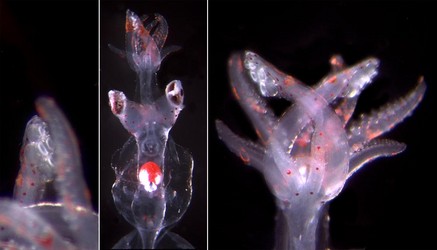
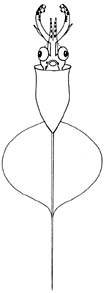

Figure. Left - Ventral views of tentacular club, brachial crown and paralarva of L. grimaldii, 10 mm ML, off Hawaii. The digestive gland is bright red and spindle-shaped, although it appears round in ventral view, and is located well posterior to the cephalic cartilage. Photographs from Young, et al. (1998). Right - Ventral view of a paralarva of L. grimaldii and an oral view of its tentacular club, 9.7 mm ML. Note the terminal position of the fins. Drawing from Young, 1991.
A juvenile was described by Clarke (1964). The juvenile had abortive tentacles, about 3 mm in length, with a few abortive suckers lacking horny rings. The tentacles in a 85 mm ML juvenile were slightly smaller.


Figure. Side view of L. grimaldii, 60 mm ML. Photograph from Clarke (1964
An intact adult was first described by Clarke and Maul (1962). No remnant of the tentacles remain in the adult.
Distribution
This species is known from the tropical and subtropical of the regions of the Atlantic, Pacific and Indian Oceans (Nesis, 1982/87).
References
Berry, S. S. 1920. Preliminary diagnoses of new cephalopods from the western Atlantic. Proc. U.S. Nat. Mus. 58: 293-300.
Clarke, M. R. 1964. Young stages of Lepidoteuthis grimaldii (Cephalopoda, Decapoda). Proc. Malac. Soc. Lond., 36: 69-78.
Clarke, M. R. and G. E. Maul. 1962. A description of the "scaled" squid Lepidoteuthis grimaldi Joubin 1895. Proc. Zool. Soc. Lond., 139: 97-118.
Jackson, G. and S. O'Shea. 2003. Unique hooks in the male scaled squid Lepidoteuthis grimaldi. J. Mar. Biol. Ass. U.K., 83: 1099-1100.
Nesis, K. N. 1982/87. Abridged key to the cephalopod mollusks of the world's ocean. 385+ii pp. Light and Food Industry Publishing House, Moscow. (In Russian.). Translated into English by B. S. Levitov, ed. by L. A. Burgess (1987), Cephalopods of the world. T. F. H. Publications, Neptune City, NJ, 351pp.
Young, R. E. (1991). Chiroteuthid and related paralarvae from Hawaiian waters. Bull. Mar. Sci., 49: 162-185.
Young, R. E., M. Vecchione and D. Donovan. 1998. The evolution of coleoid cephalopods and their present biodiversity and ecology. South African Jour. Mar. Sci., 20: 393-420.
Title Illustrations

| Scientific Name | Lepidoteuthis grimaldii |
|---|---|
| Location | N.E. Chatham Rise off New Zealand, at 42°59'S, 175°54'W |
| Comments | Caught in bottom trawl at 812 m depth |
| Acknowledgements | National Institute of Water & Atmospheric Research (NIWA) |
| Specimen Condition | Fresh |
| Identified By | Darren Stevens |
| Sex | Female |
| View | Dorsal |
| Size | 617 mm ML, 4070 g weight |
| Collector | NIWA |
| Image Use |
 This media file is licensed under the Creative Commons Attribution License - Version 3.0. This media file is licensed under the Creative Commons Attribution License - Version 3.0.
|
| Copyright | © |
About This Page

University of Hawaii, Honolulu, HI, USA

National Museum of Natural History, Washington, D. C. , USA
Page copyright © 2019
 Page: Tree of Life
Lepidoteuthidae . Lepidoteuthis grimaldii . The scaled squid.
Authored by
Richard E. Young and Michael Vecchione.
The TEXT of this page is licensed under the
Creative Commons Attribution-NonCommercial License - Version 3.0. Note that images and other media
featured on this page are each governed by their own license, and they may or may not be available
for reuse. Click on an image or a media link to access the media data window, which provides the
relevant licensing information. For the general terms and conditions of ToL material reuse and
redistribution, please see the Tree of Life Copyright
Policies.
Page: Tree of Life
Lepidoteuthidae . Lepidoteuthis grimaldii . The scaled squid.
Authored by
Richard E. Young and Michael Vecchione.
The TEXT of this page is licensed under the
Creative Commons Attribution-NonCommercial License - Version 3.0. Note that images and other media
featured on this page are each governed by their own license, and they may or may not be available
for reuse. Click on an image or a media link to access the media data window, which provides the
relevant licensing information. For the general terms and conditions of ToL material reuse and
redistribution, please see the Tree of Life Copyright
Policies.
- Content changed 16 November 2016
Citing this page:
Young, Richard E. and Michael Vecchione. 2016. Lepidoteuthidae . Lepidoteuthis grimaldii . The scaled squid. Version 16 November 2016 (under construction). http://tolweb.org/Lepidoteuthis_grimaldii/19833/2016.11.16 in The Tree of Life Web Project, http://tolweb.org/




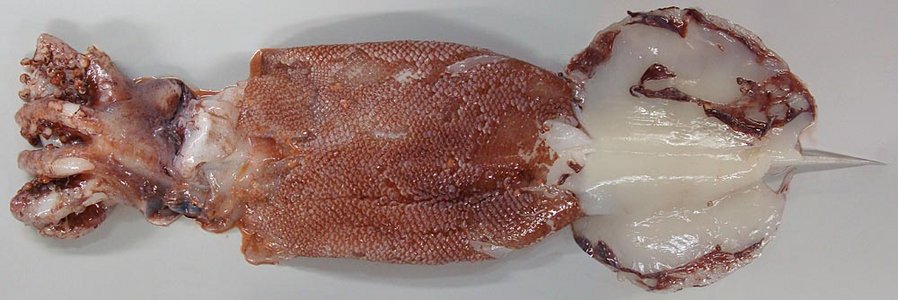
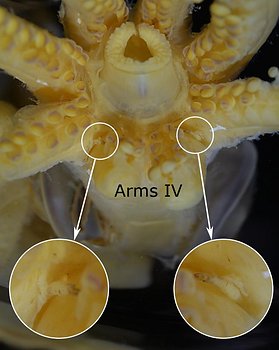
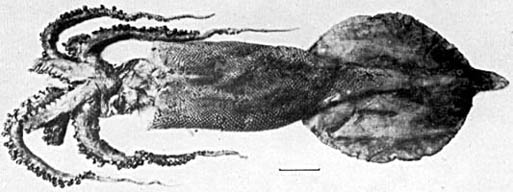



 Go to quick links
Go to quick search
Go to navigation for this section of the ToL site
Go to detailed links for the ToL site
Go to quick links
Go to quick search
Go to navigation for this section of the ToL site
Go to detailed links for the ToL site